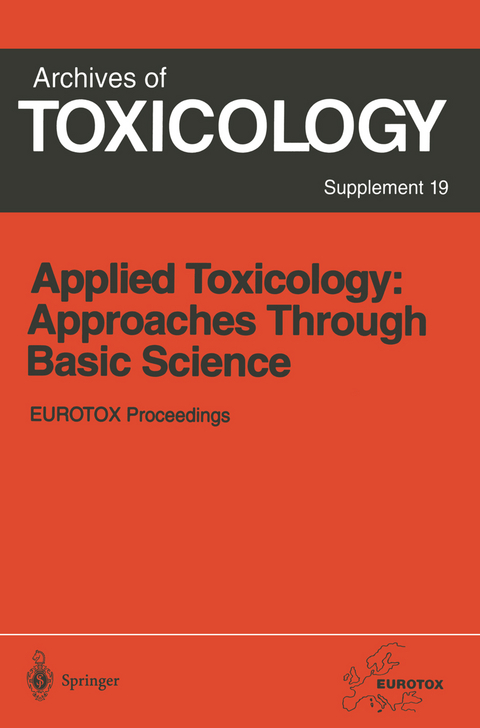
Applied Toxicology: Approaches Through Basic Science
Springer Berlin (Verlag)
978-3-642-64505-1 (ISBN)
The Gerhard Zbinden Memorial Lecture.- Genetic Polymorphism of Drug Metabolizing Enzymes. Implications for Toxicity of Drugs and Other Xenobiotics.- Detection of Chemically-Induced Changes in p53 Expression.- Looking at p53: Theoretical Implications and Methodological Aspects.- Norman Aldridge Memorial Symposium: Toxicologists versus Toxicological Disasters: Toxic Oil Syndrome.- Toxicologists versus Toxicological Disasters: Toxic Oil Syndrome, Clinical Aspects.- Epidemiology of the Toxic Oil Syndrome.- Analytical Measurements of Products of Aniline and Triglycerides in Oil Samples Associated with the Toxic Oil Syndrome.- Immunological Aspects of the Toxic Oil Syndrome.- Altered Gene Expression and Immunotoxicity.- Regulation and Mechanisms of Apoptosis in T Lymphocytes.- Immunoregulatory Genes and Immunosuppression by Glucocorticoids.- Molecular Aspects of UVB-Induced Immunosuppression.- The Use of Ecotoxicology and Human Toxicology in the Regulation of Chemical Safety in the European Union.- Options for the Regulation and Control of the Environmental Impact and Human Health Consequences of Chemicals in the European Union.- The Identification of Thresholds of Acceptability and Danger: The Chemical Presence Route.- The Identification of Thresholds of Acceptability and Danger: The Biological Route.- The Precautionary Principle and Science-based Limits in Regulatory Toxicology: The Human Experience, Individual Protection.- The Environmental Experience: Ecosystem Protection.- Is Sustainable Development a Practical Possibility Given the Continued Use of Plant Protection Products? - The Scientific View -.- Regulations and Risk Assessments on the Ecotoxicological Impact from the Use of Plant Protection Products in the European Union - an Industry Viewpoint.- Challengesin Analytical Toxicology.- Analytical Development for Low Molecular Weight Xenobiotic Compounds.- Air Pollution and Allergy.- Pollution and the Development of Allergy: The East and West Germany Story.- Nasal Lavage Biomarkers in Air Pollution Epidemiology.- Prediction of Individual Susceptibility to Toxicants.- Physiological Factors Predisposing to Neurotoxicity.- Cellular and Molecular Mechanisms of Cutaneous Toxicity.- Epidermal Cytokines and the Induction of Allergic and Non-Allergic Contact Dermatitis.- Validation of In Vitro Methods to Single Out Photoirritants Using Mechanistically Based Tests.- Assessment of the Phototoxicity Risk of New Drugs.- Progress in Antidotic Therapy.- Evolution of Antidotal Therapy in Recent Decades.- A Critical Review of Antidotal Immunotherapy for low Molecular Wight Toxins. Current Antidotes and Perspectives.- The Use of Antidotes in the Management of Central Nervous System Depression.- Antidotes: Availability, Use and Cost in Hospital and Extra-Hospital Emergency Services of Catalonia (Spain).- The Relative Efficacy of Antidotes: The IPCS Evaluation Series.- In Vitro Cell Models for Investigating Molecular Mechanisms of Toxicity.- In Vitro Investigation of the Molecular Mechanisms of Hepatotoxicity.- Protein Targets of Neurotoxicity.- Neuropathy Target Esterase (NTE): Molecular Characterisation and Cellular Localisation.- The Concept and Target of Promotion of Axonopathies.- Mechanisms and Models of Neurotoxicity of n-Hexane and Related Solvents.- Bovine Chromaffin Cells as in vitro Model for the Study of non-Cholinergic Toxic Effects of Organophosphorus Compounds.- Carcinogenesis Mechanisms in Transgenic Mouse Models.- Hepatic Tumor Induction in c-Myc mono-transgenic and TGF-?/c-Myc double- transgenic Mice.- Interactions of TCDDwith Signal Transduction and Neoplastic Development in c-myc Transgenic and TGF-alpha Transgenic Mice.- Lymphoma Induction by Heterocyclic Amines in Eµ-pim-1 Transgenic Mice.- Algal Toxins and Human Health.- Health Effects Associated With Algal Toxins From Seafood.- Cyanobacterial Toxins: Occurrence, Modes of Action, Health Effects and Exposure Routes.- The Young Scientist Poster Award.- Molecular Cloning of Neuropathy Target Esterase.
| Erscheint lt. Verlag | 16.9.2011 |
|---|---|
| Reihe/Serie | Archives of Toxicology |
| Zusatzinfo | XII, 417 p. 2 illus. in color. |
| Verlagsort | Berlin |
| Sprache | englisch |
| Maße | 155 x 235 mm |
| Gewicht | 650 g |
| Themenwelt | Medizin / Pharmazie ► Medizinische Fachgebiete ► Pharmakologie / Pharmakotherapie |
| Medizin / Pharmazie ► Pharmazie | |
| Schlagworte | Apoptosis • ecotoxicology • enzymes • gene expression • Immunotoxicology • Immuntoxikologie • Mechanismen der Toxizität • mechanisms of toxicity • neurotoxicity • Ökotoxikologie • toxic oil syndrome • Toxisches Öl-Syndrom • Transgene Tiere • Transgenic animals |
| ISBN-10 | 3-642-64505-4 / 3642645054 |
| ISBN-13 | 978-3-642-64505-1 / 9783642645051 |
| Zustand | Neuware |
| Haben Sie eine Frage zum Produkt? |
aus dem Bereich


